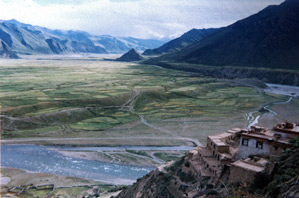


The stronghold of Drikung Dzongsar Tashizug (‘bri gung rdzong gsar bkra shis gzugs), on a rocky spur at a distance of ten kilometers from Yangrigar Monastery, commands the mountain ridge at the junction of the rivers Shorong and Kyichu. This Drikung monastery and fortress (rdzong) was built on this site in the 17th century after the repeated destruction of the previous stronghold during battles of Mongol troops. The original structure was situated on a mountain slope across the valley to the south. Drikung Dzong became the administrative headquarters of the district belonging to the Drikung Kagyu order.
Drikung Dzong’s building style, with steep stairways clinging to the slope and mighty, pitched walls was reminiscent of the Potala Palace in Lhasa. Drikung Dzong has inspired reverence and envy throughout the centuries and was often the object of hostile encroachment. During the 1st Chungtsang Rigzin Chodrak’s (1595-1659) lifetime the central government had confiscated Drikung Dzong. The 2nd Chetsang Thrinle Sangpo (1656-1718) entered into negotiations with the government and was granted permission to take over the Dzong again in 1715. In the meantime, the government in Lhasa had built up the area around the Barkhor and had removed costly roofs and expensive building materials from Drikung Dzong and carried them off to the capital.
Drikung Dzong was divided into four main residential quarters, the upper, the lower, the western and the eastern. The large assembly hall (tshoms chen) and the temple of the three Drikung protector deities were situated in the center. The residences of the Kyabgon Rinpoches were on top of the building. In the upper section lived the Kyabgon Rinpoche’s servants, household servants, the shrine master, the cook, the teachers of the Kyabgon Rinpoches (yongs ‘dzin), the secretary, and the commissary of stores. The lower area accommodated the secular administration of Drikung, consisting of the manager, the bursar, the secretary for external affairs, the undersecretary, the head purchasing agent, the steward of firewood, and the stableman.
Drikung Dzong owned an important library which not only housed many invaluable religious and historical texts, but also all the contracts the Drikungpa had signed with the central government since the time of the 5th Dalai Lama. Significant documents for the history of the Drikung Kagyu order kept there included comprehensive lists of all Drikung monasteries and of Rinpoches and lamas as well as minute inventories of all the major monasteries. The temples in the compound were decorated with many beautiful statues and thangkas. The library was destroyed and all the valuable objects in the entire edifice were taken away when Drikung Dzong was looted soon after the Tibetan Uprising of 1959. Subsequently the buildings decayed as the local populace carried off wooden beams and other material they could use for heating or building.
Today only a small part of Drikung Dzong has been restored and a few monks are looking after it. Gelong Tsondu Tsundu has made considerable efforts to rebuild the monastery, but it is impossible to reconstruct the main building. With the help of a few monks he has reconstructed the main assembly hall and the living quarters of the Kyabgon Rinpoches.
Recently the Chinese built a dam for a hydroelectric plant and flooded the entire large valley just below Drikung Dzong. Quite a few families had to be relocated and many villages disappeared. Now the remnants of Drikung Dzong are overlooking a lake instead of fields and rivers. There is no regular monastic live at Drikung Dzong at present. Only a handful of monks live there permanently to look after the buildings.

